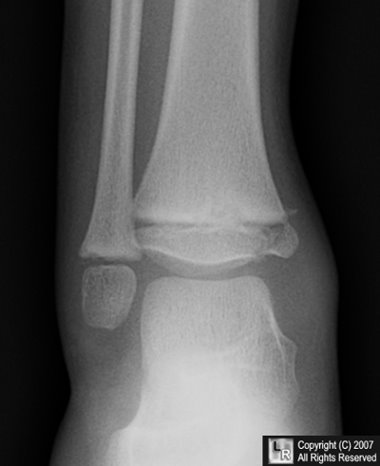
| Cardiac | |
|---|---|
| GI | |
| Bone | |
| GU | |
| Neuro | |
| Faculty | |
| Student | |
| Quizzes | |
| Image DDX | |
| Misc |
What's the most likely diagnosis?
- 10 year-old with pain in ankle after fall
- Salter-Harris I fracture
- Salter-Harris II fracture
- Salter-Harris III fracture
- Salter-Harris IV fracture
- Salter-Harris V fracture
![]()
Answer:
4. Salter-Harris IV fracture
More (Click Discussion Tab)
Salter-Harris Fractures
- General Considerations
- The epiphyseal pclate (physis or growth plate) is the weakest part of the bone to shearing injuries
- The Salter-Harris classification is a means of categorizing epiphyseal plate fractures and provides clues to their prognosis
- All such fractures, by definition, involve or extend through the epiphyseal plate so that all such fractures occur in children before the epiphyseal plate closes
- Salter-Harris I Fractures
- Occurs through the hypertrophic zone of the epiphyseal plate
- Only the epiphyseal plate is fractured
- Rarely produces complications
- May be difficult to diagnose unless there is visible displacement of the epiphysis on the metaphysis
- Slipped capital femoral epiphysis (SCFE) is an example of a Salter-Harris I fracture
- Salter-Harris II Fractures
- Most common Salter-Harris fracture -85%
- Involves both the epiphyseal plate and the metaphysis
- Small corner of metaphysis that is usually fractured produces the “corner sign”
- Rarely produces complications
|
Available Now!
Click Cover for More Information

320 Pages!
Over 500 photos!
With StudentConsult.com
Online Access
Order Now!
LearningRadiology.com is an award-winning educational site aimed primarily at medical students and radiology residents-in-training, containing lectures, handouts, images, Cases of the Week, archives of case quizzes, flashcards of differential diagnoses and “most commons” lists, primarily in the areas of chest, GI, cardiac, and bone radiology.


